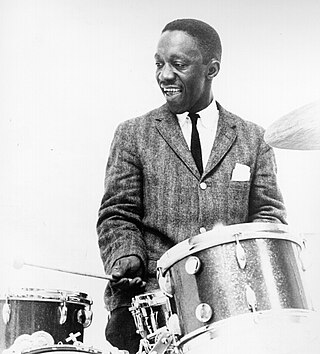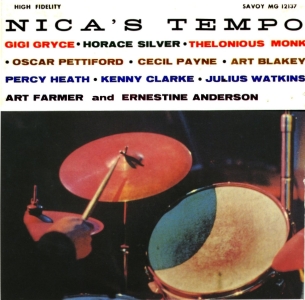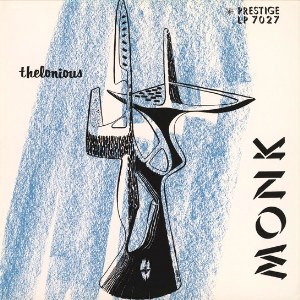Related Research Articles

Earl Rudolph "Bud" Powell was an American jazz pianist and composer. A pioneer in the development of bebop and its associated contributions to jazz theory, Powell's application of complex phrasing to the piano influenced both his contemporaries and later pianists including Walter Davis Jr., Toshiko Akiyoshi, and Barry Harris.

Horace Ward Martin Tavares Silver was an American jazz pianist, composer, and arranger, particularly in the hard bop style that he helped pioneer in the 1950s.

Arthur Blakey was an American jazz drummer and bandleader. He was also known as Abdullah Ibn Buhaina after he converted to Islam for a short time in the late 1940s.

Clifford Benjamin Brown was an American jazz trumpeter, pianist and composer. He died at the age of 25 in a car crash, leaving behind four years' worth of recordings. His compositions "Sandu", "Joy Spring", and "Daahoud" have become jazz standards. Brown won the DownBeat magazine Critics' Poll for New Star of the Year in 1954; he was inducted into the DownBeat Hall of Fame in 1972.

Robert Henry Timmons was an American jazz pianist and composer. He was a sideman in Art Blakey's Jazz Messengers for two periods, between which he was part of Cannonball Adderley's band. Several of Timmons' compositions written when part of these bands – including "Moanin'", "Dat Dere", and "This Here" – enjoyed commercial success and brought him more attention. In the early and mid-1960s he led a series of piano trios that toured and recorded extensively.

Dillon "Curley" Russell was an American jazz musician, who played bass on many bebop recordings.
Blue Haze is a compilation album of tracks recorded in 1953 and 1954 by Miles Davis for Prestige Records.

Miles Davis, Volumes 1 & 2 are a pair of separate but related albums by American jazz trumpeter Miles Davis recorded on May 9, 1952, April 20, 1953 and March 6, 1954 and released on Blue Note early 1956. The three sessions were originally released on ten-inch LPs as Young Man with a Horn (1953), Miles Davis, Vol. 2 (1953) and Miles Davis, Vol. 3 (1954), respectively.

Robert Broom Jr. is an American jazz guitarist, composer, and educator. He was born and raised in New York City, then moved to Chicago, which has been his home town since 1984. He performs and records with The Bobby Broom Trio and his organ group, The Bobby Broom Organi-Sation. While versed in the traditional jazz idioms, Broom draws from a variety of American music forms, such as funk, soul, R&B, and blues.
Louis "Sabu" Martinez was an American conguero of Puerto Rican descent. A prominent player in the Cubop movement, Martinez appeared on many important recordings and live performances during that period. Martinez also recorded several Latin jazz albums, now recognized as classics of the genre.

Nica's Tempo is the most common latter-day title of an album by the Gigi Gryce Orchestra and Quartet, recorded and first released in late 1955.

Hank Mobley Quintet, also known as Hank Mobley with Farmer, Silver, Watkins, Blakey, is an album by American jazz saxophonist Hank Mobley recorded on March 8, 1957 and released on Blue Note later that year. The quintet features trumpeter Art Farmer and rhythm section Horace Silver, Doug Watkins and Art Blakey.

Thelonious Monk Trio is an album by American jazz pianist and composer Thelonious Monk. The album features his earliest recordings for Prestige Records, performing as a soloist with a rhythm section of bassist Gary Mapp, either Art Blakey or Max Roach on drums, and one track with Percy Heath replacing Mapp. It also contains the earliest recorded versions of the jazz standards "Blue Monk" and "Bemsha Swing".

Thelonious Monk and Sonny Rollins is a compilation album by jazz pianist and composer Thelonious Monk and saxophonist Sonny Rollins released in 1956 by Prestige Records. The tracks on it were recorded in three sessions between 1953 and 1954. While this is its original title, and its most consistent title in its digital re-releases, it was also released on Prestige as Work! and The Genius Of Thelonious Monk, with alternative covers.
Quicksilver is a song, which became a hit for Bing Crosby in 1950. It was written by Eddie Pola, George Wyle and Irving Taylor.

Blakey is an album by drummer Art Blakey recorded in 1954 and originally released on the EmArcy label as a 10-inch LP. The album was rereleased on CD in 1999 with bonus tracks originally released on the album Introducing Joe Gordon. The album has also been released as "The Complete Art Blakey on EmArcy", including four songs from a March 24 recording session.

The Jazz Messengers were a jazz combo that existed for over thirty-five years beginning in the early 1950s as a collective, and ending when long-time leader and founding drummer Art Blakey died in 1990. Blakey led or co-led the group from the outset. "Art Blakey" and "Jazz Messengers" became synonymous over the years, though Blakey did lead non-Messenger recording sessions and played as a sideman for other groups throughout his career.
"Yes sir, I'm gonna to stay with the youngsters. When these get too old, I'm gonna get some younger ones. Keeps the mind active."

Horace Silver Trio & Art Blakey–Sabu is an album by the Horace Silver Trio featuring drummer Art Blakey and conga player Sabu, recorded on October 9 & 20, 1952 and November 23, 1953 respectively and released on Blue Note in 1956.
"The Preacher" is a composition by Horace Silver. The original version was recorded by Silver's quintet on February 6, 1955. It was soon covered by other musicians, including with lyrics added by Babs Gonzales. It has become a jazz standard.
"Doodlin'" is a composition by Horace Silver. The original version, by Silver's quintet, was recorded on November 13, 1954. It was soon covered by other musicians, including with lyrics added by Jon Hendricks. It has become a jazz standard.
References
- ↑ "Horace Silver – Obituary". The Daily Telegraph. June 19, 2014.
- ↑ Jenkins Jr., Everett (2001). Pan-African Chronology III. McFarland. p. 472.
- ↑ Koransky, Jason (March 2004). "The Songs Are My Life". DownBeat . 71 (3): 32–38.
- ↑ Silver, Horace (2006). Let's Get to the Nitty Gritty: The Autobiography of Horace Silver. University of California Press. p. 203. ISBN 978-0-520-25392-6.
- ↑ "Reviews of New Jazz Records" (June 19, 1954) The Billboard. p. 40.
- ↑ McDonough, John (September 2014) "Horace Silver". Down Beat p. 49.